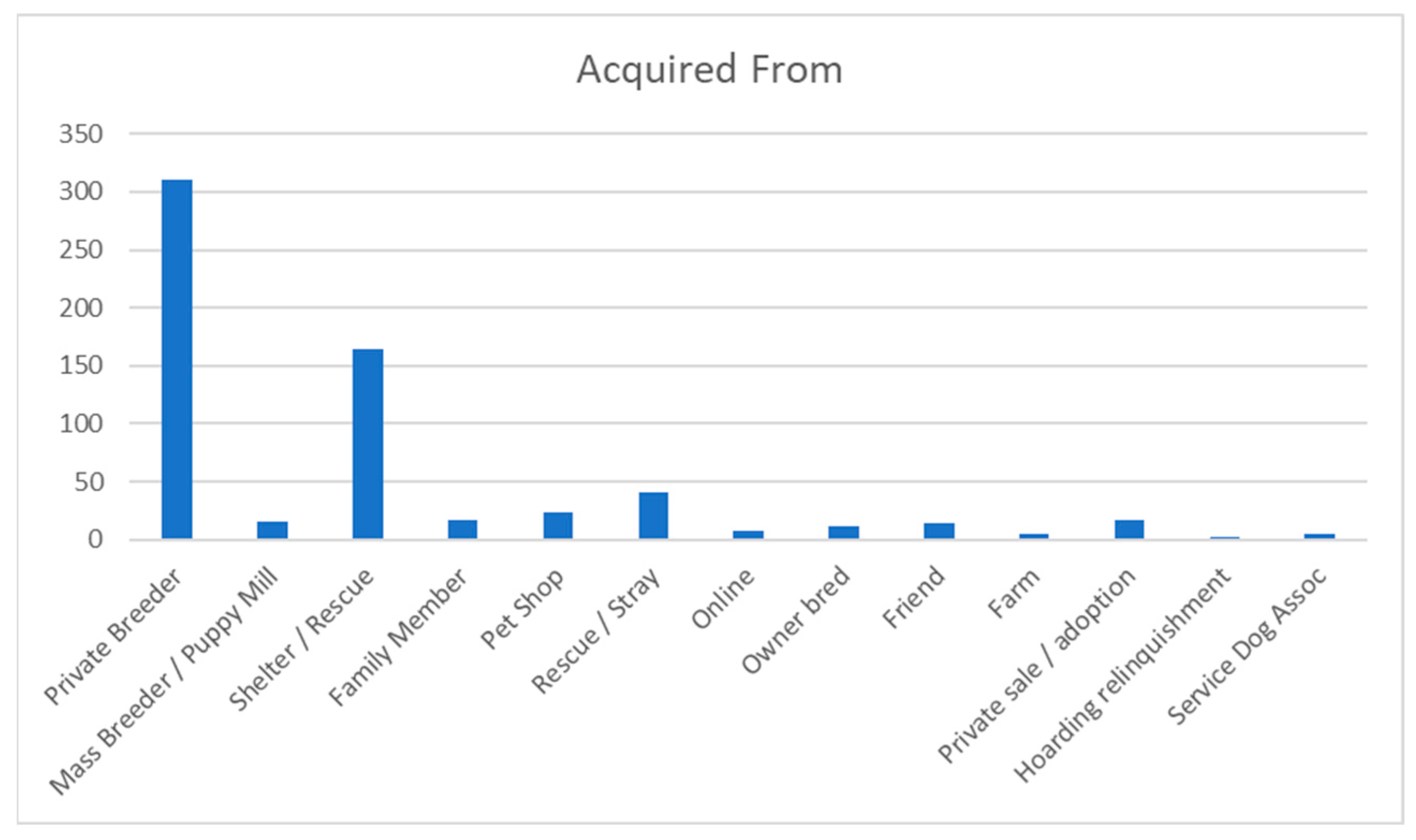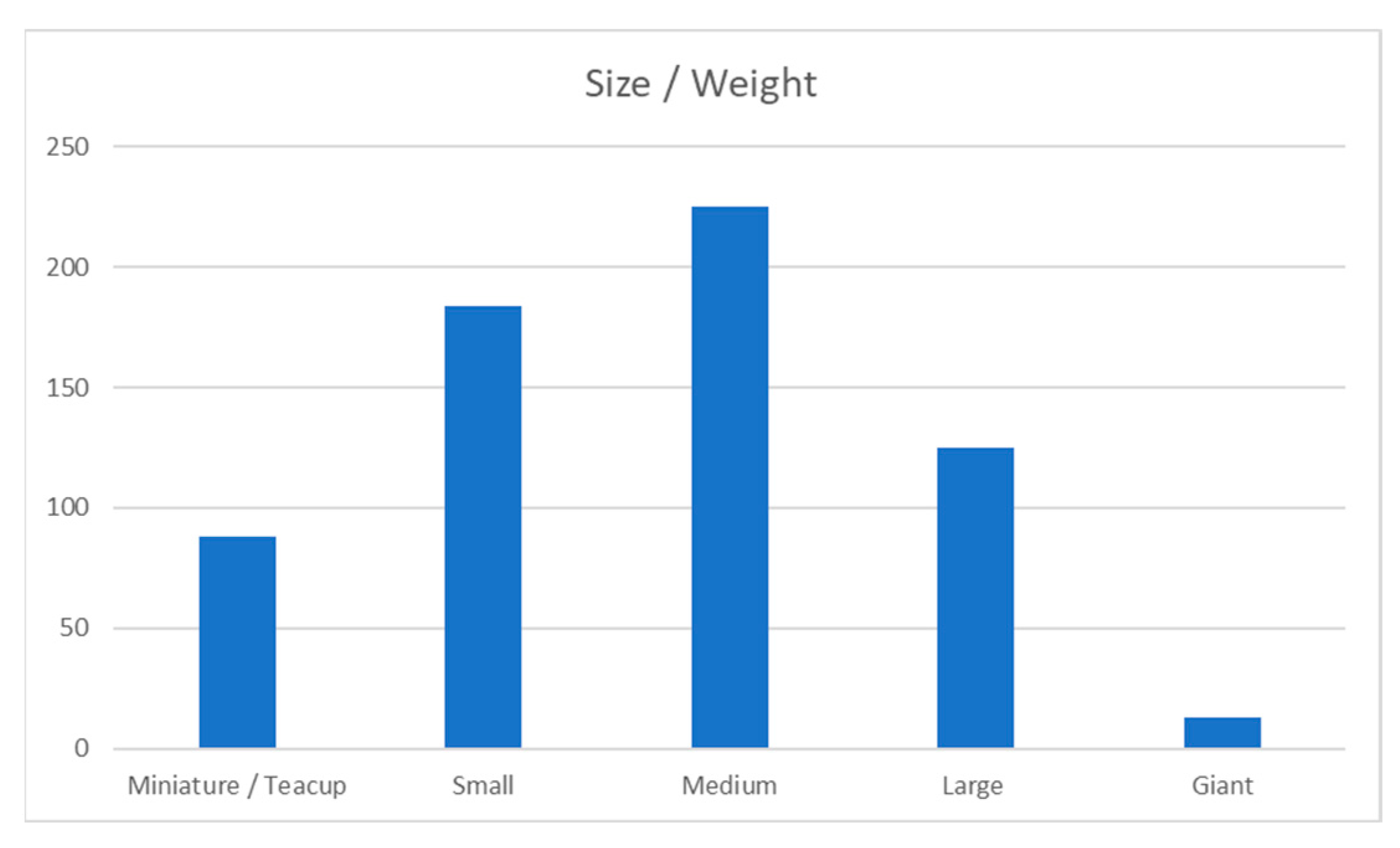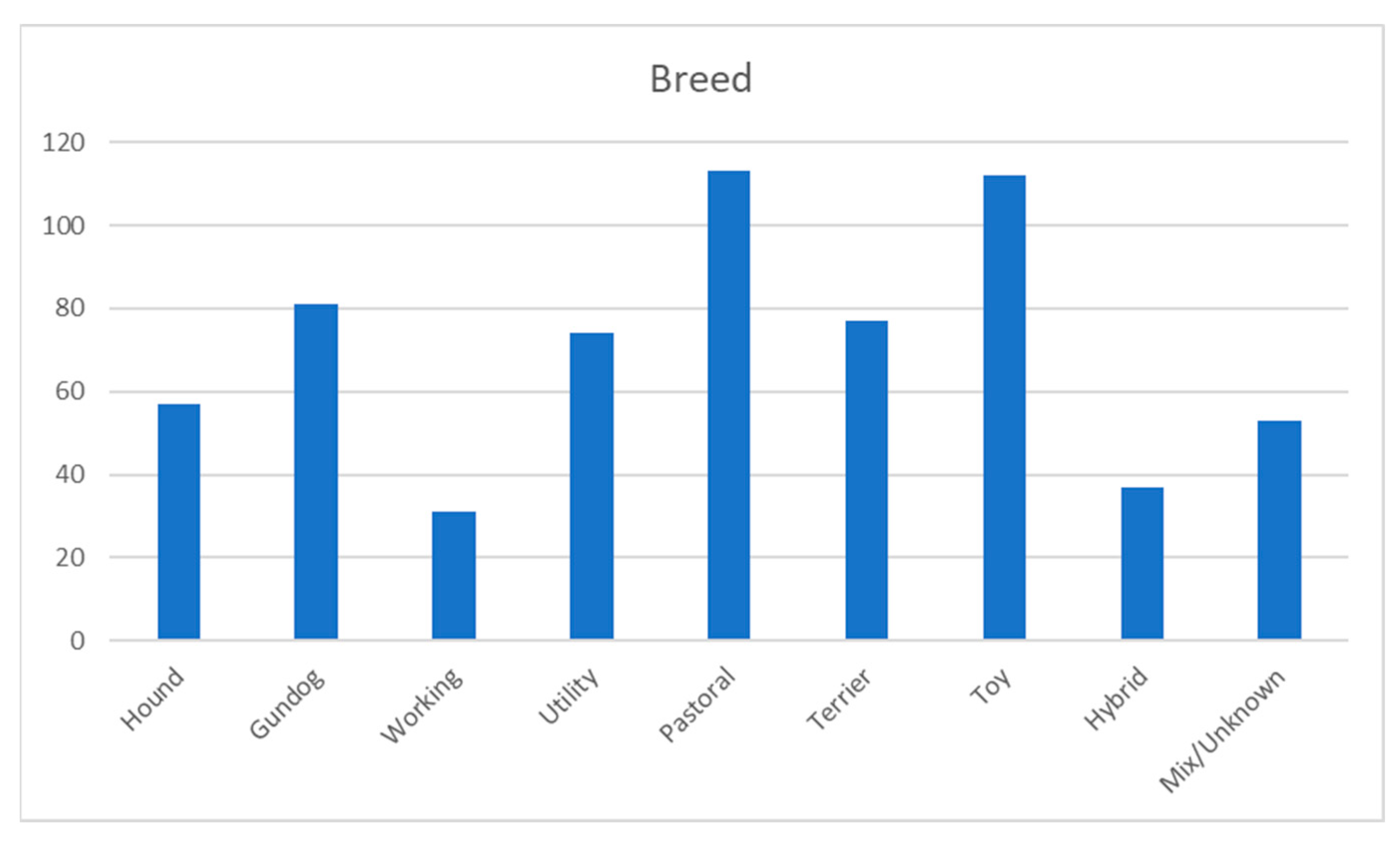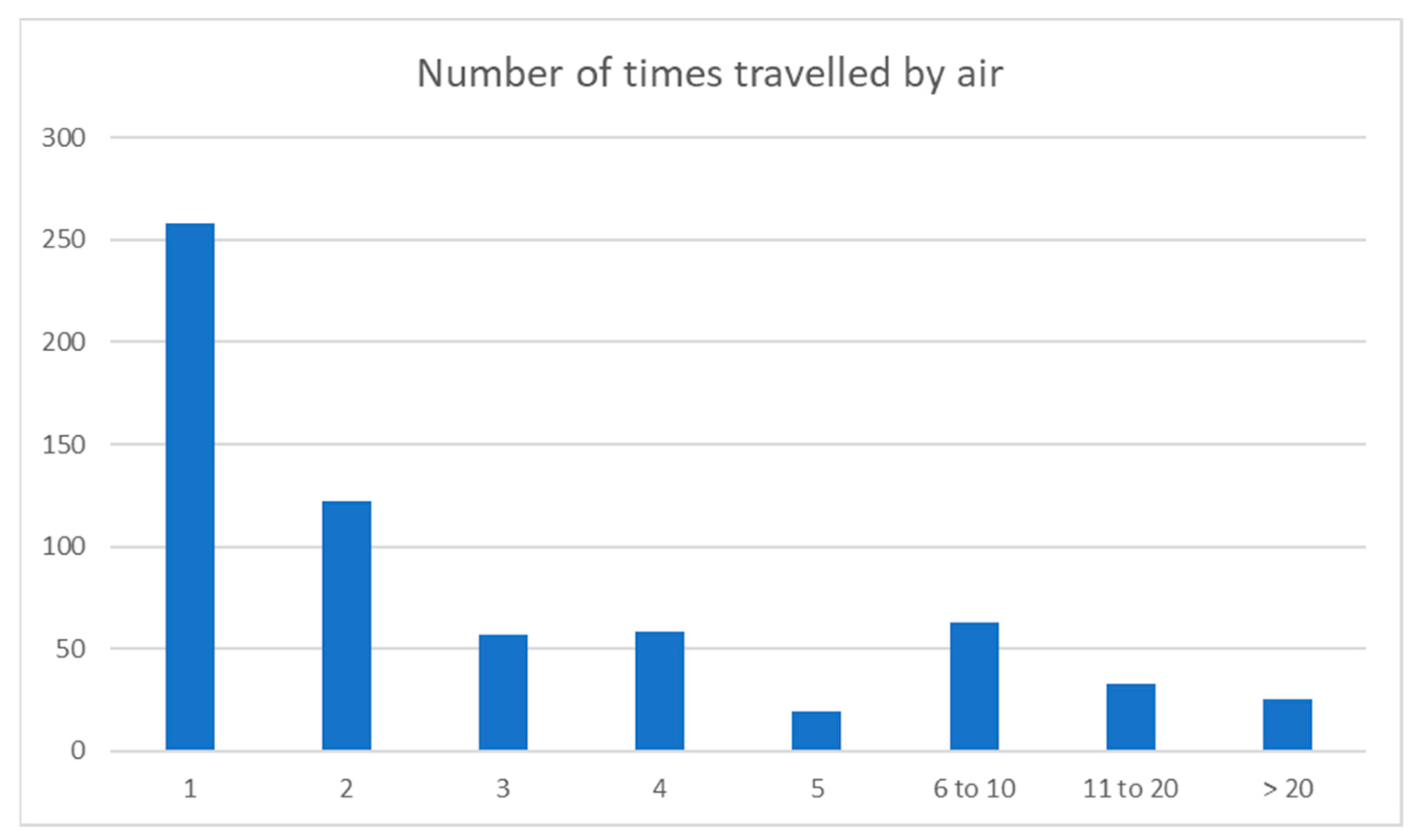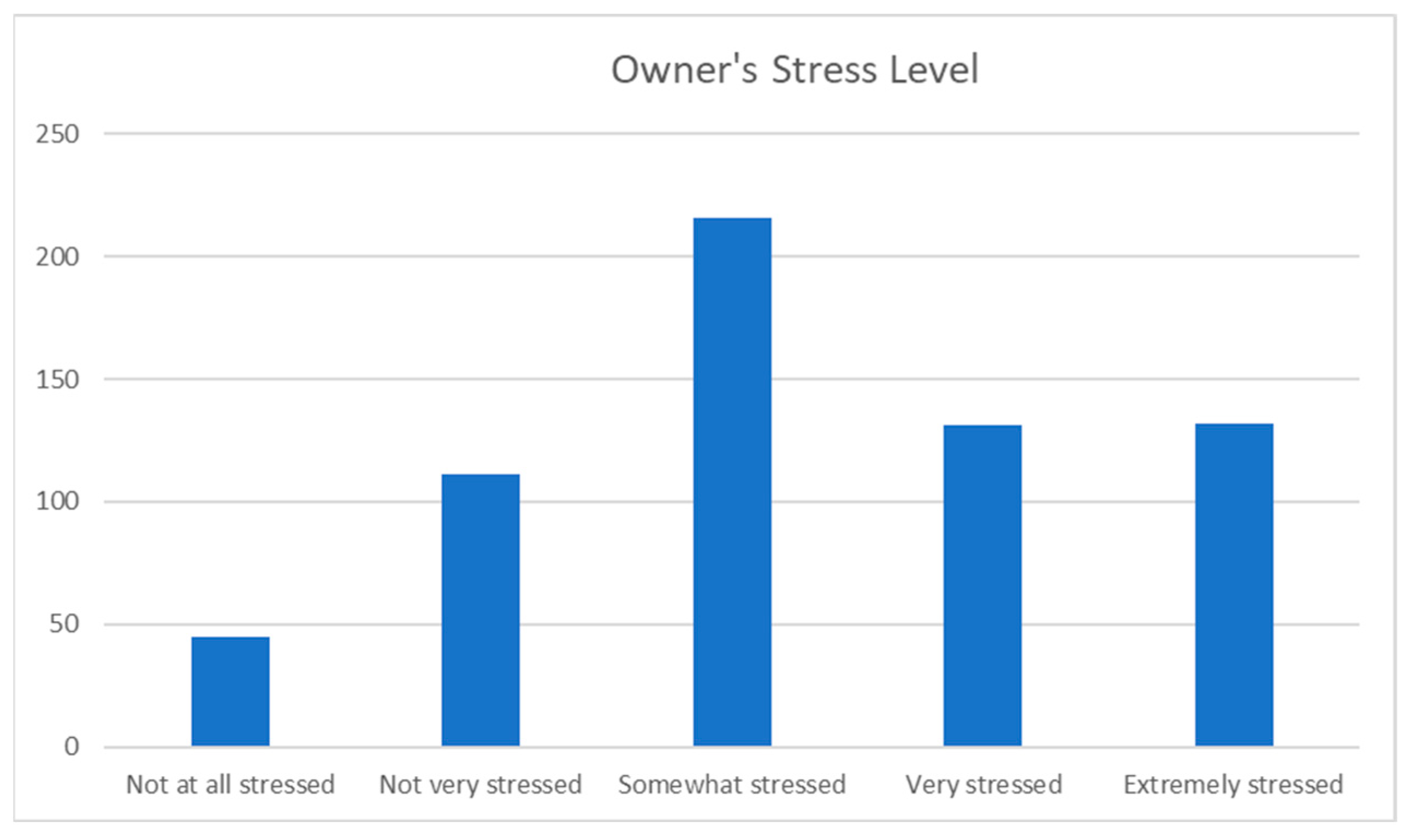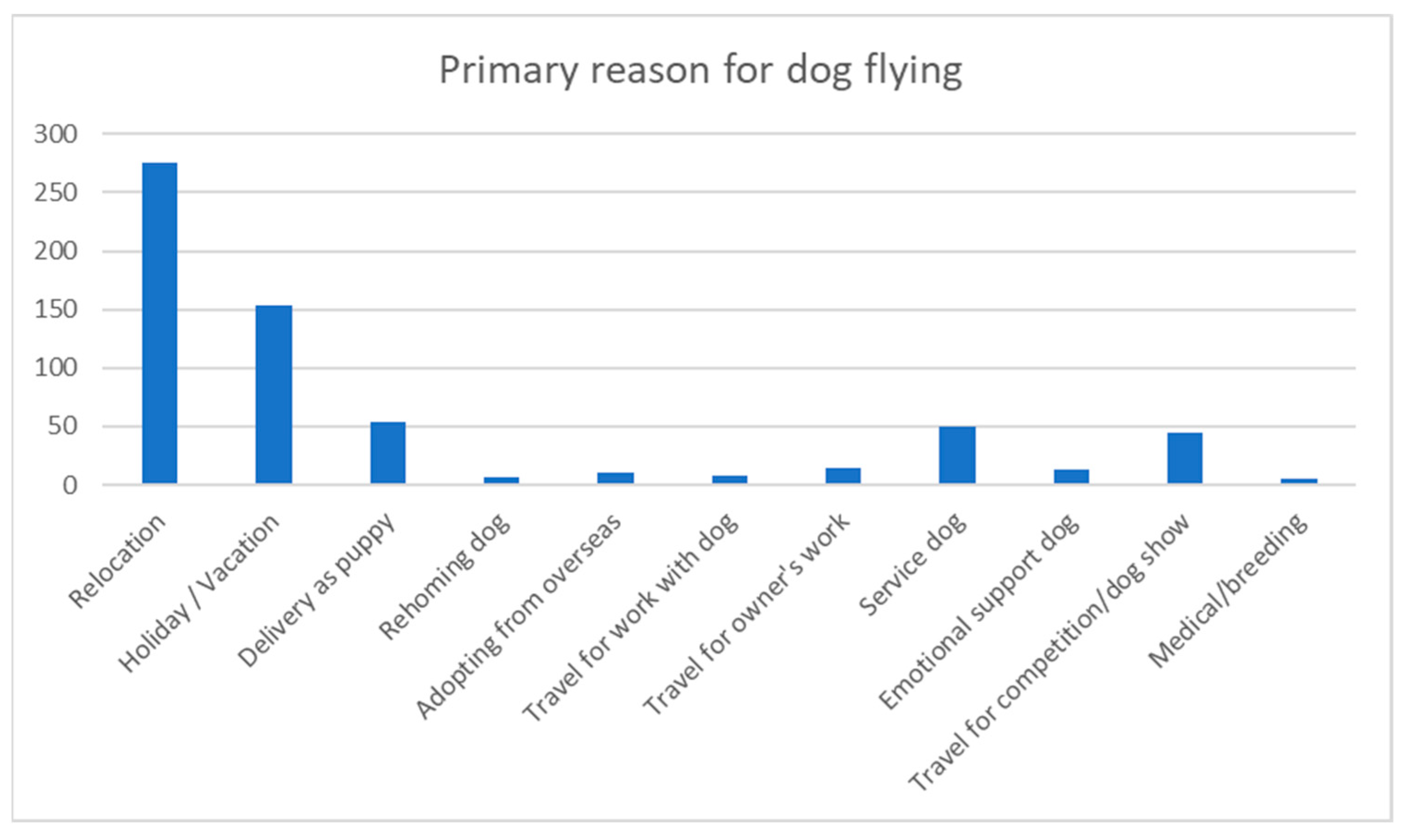3.3.1. Logistics and Preparation for Air Travel
The primary reason for dogs travelling by air in this survey was relocation (43.5%). This was followed by taking the dog on vacation (24.3%). Moreover, 8.5% of participants received their dog via air transportation as puppies, 7.9% of dogs travelled as service dogs, and 6.9% of dogs travelled to dog shows or competitions (see
Figure 6).
Most flights both originated (52.8%) and terminated (44.4%) in North America, 22% originated and 31% terminated in Europe, 9.1% originated and 10.1% terminated in the Middle East/Africa and 8.5% originated and 5.4% terminated in Asia.
Most flights (60.9%) were direct flights, 33.1% of flights had 1 stop/layover, and 6% of flights had multiple stops/layovers.
35.4% of trips were termed long trips (10–24 h), 26.1% were medium-length trips (6–10 h), 24.3% were short trips (1–6 h), 9.4% were multi-leg with multiple stopovers, and only 4.7% were long/multi-leg trips with boarding and/or quarantine stays.
Participants were asked where their dogs were cared for during different stages of the flight and were asked specifically about dedicated airport animal lounges, where dogs are kept in separated, temperature-controlled environments, are possibly taken out of their crates and offered food and water, and possibly examined by a veterinarian or non-veterinary care assistant. Dedicated airport animal lounges, if present, are usually part of the cargo shipment area and would not be used by dogs travelling in the cabin. A total of 8.4% said that their dogs did not visit a dedicated airport animal lounge, 24.9% of participants said that yes, their dog was cared for at a dedicated airport animal lounge at least at one point of air travel and 16.7% of participants did not know what a dedicated airport animal lounge was or did not know where their dog was cared for during air travel.
A total of 51.2% of dogs travelled in the hold of the aircraft, and 48.5% of dogs travelled in the cabin, either on a leash or in a carrier and either with the participant or another accompanying person.
A total of 13 dogs (2%) were said to be emotional support dogs, and of these, 11 travelled in the cabin with the participant.
Moreover, 23.1% of participants used a pet shipping company to plan the entire process of pet air travel, 66.8% planned and prepared the trip completely by themselves, and 10.1% used a pet shipping company for some aspects of the trip preparation and planned other aspects themselves.
Most participants (21.6%) started preparing their dogs for air travel 1–4 weeks before the travel date, with the second largest group (18.1%) beginning preparation 1–3 months before travel. A smaller number of owners started preparing more than 6 months before travel (14.3%), and surprisingly, 13.9% only started preparing their dogs 24 h to 1 week before travel. Around 10% each started 3–6 months before travel, 1 day before travel, or did not prepare their dogs for travel themselves (see
Figure 7).
Over half of the participants (55.3%) stated that they did not seek any advice from professionals, and 6.5% used their own previous experience to prepare their dogs for air travel.
Of the participants that sought advice from professionals, 39.5% sought advice from airlines, 37.3% from IATA (International Air Transport Association), 31.8% from books, 29.8% from veterinarians, 24.9% from the Internet/Google and 15.9% from pet shippers. Advice was sought to a lesser degree from dog trainers, other pet professionals, family members, pet shipping organisations such as IPATA (International Pet and Animal Transportation Association) and ATA (Animal Transportation Association), social media, breeders, and government agencies (see
Table 4).
When asked about the preparation of their dog for air travel, 67.4% of participants crate-trained their dogs prior to air travel, 74.8% visited a veterinarian to perform a physical examination on their dog, and 79.2% visited a veterinarian to perform required vaccinations, blood tests, microchip placement or parasite treatments prior to air travel.
When asked about the use of stress management or calming products, 13.4% of participants used anxiolytic medications, 12.8% used calming supplements, 9.8% used pheromone products, and 2% used a calming diet in preparation for or during the flight. A total of 5.8% of participants used CBD/hemp products, and 3.1% used aromatherapy products. A total of 76.7% of participants did not use any kind of stress management products (medications, pheromones, supplements, and diets), and seven participants (1.1%) were pro-actively advised not to use any kinds of calming or anxiolytic products before or during air travel. When anxiolytic medication or supplements were used, 49 participants (7.7%) used trazodone, 34 (5.4%) used gabapentin, 11 (1.7%) used alpha-casozepine (Zylkene®, Vetoquinol—Lure, France), 10 (1.6%) used a benzodiazepine, 6 (0.9%) each used YuCalm® (Lintbells—Hitchin, UK) and the anti-nausea medication maropitant, 3 (0.5%) each used acepromazine and Benadryl® and even fewer used clonidine, L- Theanine (Anxitane®, Virbac—Carros, France), Composure® (VetriScience—VT, USA) and Soliquin® (Nutramax—SC, USA). No participants used oromucosal dexmedetomidine gel (Sileo®, Zoetis—NJ, USA) or pregabalin.
A total of 39 participants (6.1%) used behaviour modification techniques such as desensitisation and familiarisation with certain aspects of the air travel process, four participants put familiar items in the dog’s crate, and three participants used a Thundershirt® during air travel.
Other methods of preparation included the dog losing weight (1 participant), putting a tile tracker (a Bluetooth device that can be attached to an object to track its location) on the dog’s collar (1 participant), and chartering a private jet for air travel (2 participants).
3.3.2. The Dog’s Experience of Air Travel
Participants were asked how distressed they felt their dogs were at the following points during air travel: 1. When handed over to the pet shipper or airport staff before the flight (if the dog travelled in the hold of the aircraft), 2. At the airport or during the flight (if the dog flew in a cabin with the owner or an accompanying person), 3. At the time of arrival/collection at the airport or when the dog was delivered to the participant after the flight, the results can be seen in
Table 5.
Participants were also asked whether they saw their dog displaying certain body language signs associated with stress at the three points during air travel: (1) when handed over to the pet shipper or airport staff before the flight (if the dog travelled in the hold of the aircraft), (2) at the airport or during the flight (if the dog flew in a cabin with the owner or an accompanying person), and (3) at the time of arrival/collection at the airport or when the dog was delivered to the participant after the flight (see
Table 6).
A total of 70.1% of dogs showed at least one sign of the above-mentioned stress signs at handover before the flight, 72.4% of dogs showed at least one of the above-mentioned stress signs during the flight, and 32% of dogs showed at least one of the above-mentioned signs of stress at arrival/handover after the flight.
Moreover, 3% of respondents stated that their dog had shown “other” signs of stress before, 4.1% during and 4.9% after the flight (open-ended question box). Some of these responses included being wide-eyed, the tail being tucked, being restless, unable to settle and hyper-alert to the surroundings, biting on the water bowl and mesh covering of the travel crate, chewing the leash tied onto the crate to pieces, having a raw nose from rubbing it on the crate door, being desperate to urinate and defecate, being thirsty, being tired, not wanting to eat food or treats, not moving, having trouble standing and walking, trying to escape from crate, pulling on the leash whilst walking through the airport, lunging from inside the crate when approached, and, sadly, one dog died in quarantine after the flight.
Most dogs (83.6%) did not receive medical attention from a veterinarian immediately after air travel. Of the dogs that did receive medical attention after the flight, 83 dogs (13.1%) received a routine veterinary examination, 18 dogs were seen unrelated to air travel (for example, to refill regular medication), 8 dogs were seen to treat a major health issue, 1 dog was seen to treat a minor health issue, 1 dog was seen to treat a mental/emotional/behavioural condition, and 2 dogs were seen to confirm death.
Participants were asked to comment on the dog’s stress level at various times following air travel (48 h, 3–7 days, 8–30 days, and over 30 days after air travel), and the responses can be seen in
Table 7.
Participants were asked about the dog’s behaviours and signs of stress at various times following air travel (48 h, 3–7 days, 8–30 days, over 30 days). Between 34% (2 days after air travel) and 39.4% (over 30 days after air travel) of participants stated that their dogs did not show any behaviours or signs associated with stress after air travel. Of the dogs that did show behaviours or signs associated with stress, the most commonly seen are listed in
Table 8.
A total of 30 participants (4.7%) responded that their dog had shown “other” behaviours or signs of stress after air travel. These included howling and crying when being left alone, especially for longer periods, being more alert and jumpier, being unwilling to go for a walk, being “overheated”, vomiting, and being unsettled with another dog in the household.
A total of 13.8% of participants stated that their dog developed a behaviour problem within 3 months after the flight. Moreover, 4.3% of dogs developed separation anxiety, 3% of dogs were generally more anxious, and 3.6% of dogs developed more than one of the behaviour disorders mentioned for selection in the questionnaire (see
Table 9).
A total of 8.2% of participants thought that the behaviour change was a result of the flight, 12.1% thought it was due to a change in the dog’s physical environment, and 9% thought it was due to a change in the dog’s social environment (more than one answer was possible).
A total of 10.4% of participants stated that their dog experienced worsening of an already existing behaviour problem within 3 months after the flight. Moreover, 4.1% of dogs experienced a worsening in separation anxiety, 1.1% experienced a worsening in aggressive behaviours, and 3.6% of dogs experienced a worsening of more than one of the behaviour disorders mentioned for selection in the questionnaire (see
Table 10).
A total of 5.8% of participants thought that the worsening of the behaviour problem/s was a result of the flight, 7.4% thought it was due to a change in the dog’s physical environment, and 6.3% thought it was due to a change in the dog’s social environment (more than one answer was possible).
A total of 8.3% of participants stated that their dog experienced worsening of an already existing physical illness within 3 months after the flight. Moreover, 2.7% of dogs experienced a worsening in food or environmental allergies, 1.9% experienced a worsening in osteoarthritis or musculoskeletal disease, and 1.3% of dogs experienced a worsening in gastro-intestinal disease (see
Table 11).
A total of 2.8% of participants thought that the worsening of the physical illness was a result of the flight, 5.7% thought it was due to a change in the dog’s physical environment, and 2.2% thought it was due to a change in the dog’s social environment (more than one answer was possible).
